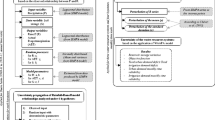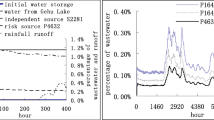Abstract
Estimating rivers’ responses to natural and man-made changes is of high importance in river water quality management. It is also necessary to incorporate uncertainties in planning and management of these important systems. The aim of this paper is simultaneously analyzing uncertainties of inputs and parameters of a river water quality simulation model using a novel Markov chain Monte Carlo technique, namely differential evolution adaptive metropolis (DREAM). This technique helps to consider the interaction between the input variables and parameters in water quality simulation results. A DREAM-based uncertainty analysis model is linked with the QUAL2K simulation model to incorporate uncertainties of several inputs and parameters such as headwater quantity and quality, pollution loads and reaeration parameters. A part of the Karoon River located at the southwestern part of Iran is selected for the case study. The results illustrate that the interactions among the parameters and inputs should be taken into account in river water quality simulation. The methodology presented in this paper can accurately provide the statistical characteristics of parameters of the water quality simulation model using the observed values of several water quantity and quality variables.















Similar content being viewed by others
References
Abrishamchi A, Tajrishi M, Shafieian P (2005) Uncertainty analysis in QUAL2E model of Zayandeh-Rood river. Water Environ Res 77(3):279–286
Ajami NK, Duan Q, Sorooshian S (2006) An integrated hydrologic Bayesian multi-model combination framework: confronting input, parameter and model structural uncertainty in hydrologic prediction. Water Resour Res 43:W01403. doi:10.1029/2005WR004745
Beven K, Binley A (1992) Future of distributed models: model calibration and uncertainty prediction. Hydrol Process 6:279–298
Cardona CM, Martin C, Salterain A, Castro A, San Martín D, Ayesa E (2011) Calhidra 3.0 new software application for river water-quality prediction based on RWQM1. Environ Model Softw 26:973–979
Chapra SC (1997) Surface water quality modeling. The McGraw-Hill Companies, Inc., New York
Chapra SC, Pelletier GJ (2003) QUAL2K: a modeling frame work for simulating river and stream water-quality: documentation and user’s manual. Civil and Environmental Department, Tufts University, Medford, MA
Chapra SC, Pelletier GJ, Tao H (2007) QUAL2K: a modeling framework for simulating river and stream water quality: documentation and user’s manual. Civil and Environmental Engineering Department, Tufts University, Medford, MA
Cho JH, Ha SR (2010) Parameter optimization of the QUAL2K model for a multiple-reach river using an influence coefficient algorithm. Sci Total Environ 408:1985–1991
Gelman A, Carlin JB, Stern HS, Rubin DB (2004) Bayesian data analysis, 2nd edn. Chapman & Hall/CRC, Boca Raton
Huisman J, Rings J, Vrugt J, Sorg J, Vereecken H (2010) Vadose zone model-data fusion: state of the art and future challenges. J Hydrol 380:62–73
Kannel PR, Lee S, Lee YS, Kanel SR, Pelletier GJ (2007) Application of automated QUAL2Kw for water quality modeling and management in the Bagmati river Nepal. Ecol Model 202:503–517
Karamouz M, Nazif S, Tavakolifar H (2009a) Assessing the risk of utilization of the urban refinement system. In: Proceedings of 8th international conference in civil engineering, Shiraz University, Shiraz, Iran (In Farsi)
Karamouz M, Kerachian R, Akhbari M, Hafez B (2009b) Design of river water quality monitoring networks: a case study. Environ Model Assess 14(6):705–714
Karamouz M, Mojahedi S, Ahmadi A (2010) Interbasin water transfer: economic water quality-based model. J Irrig Drain Eng 136(2):90–98
Karaouzas I, Dimitriou E, Skoulikidis N, Gritzalis K, Colombari E (2009) Linking hydrogeological and ecological tools for an integrated river catchment assessment. Environ Model Assess 14:677–689
Kerachian R, Karamouz M (2006) Waste-load allocation model for seasonal river water quality management: application of sequential dynamic genetic algorithms. Scientia Irancia 12(2):117–130
Kuczera G, Parent E (1998) Monte Carlo assessment of parameter uncertainty in conceptual catchment models: the metropolis algorithm. J Hydrol 211:69–85
Laloy E, Vrugt JA (2012) High-dimensional posterior exploration of hydrologic models using multiple-try DREAM (ZS) and high-performance computing. Water Resour Res 48:W01526. doi:10.1029/2011WR010608
Mannina G, Viviani G (2010) Water-quality modelling for ephemeral rivers: model development and parameter assessment. J Hydrol 393:186–196
Memarzadeh M, Mahjouri N, Kerachian R (2013) Evaluating sampling locations in river water quality monitoring networks: application of dynamic factor analysis and discrete entropy theory. Environ Earth Sci 70(6):2577–2585
Nakhaei N, Etemad-Shahidi A (2012) Applying Monte Carlo and classification tree sensitivity analysis to the Zayandehrood river. J Hydroinf 14:236–250
Nikoo MR, Kerachian R, Karimi A, Azadnia AA, Jafarzadegan K (2013) Optimal water and waste load allocation in reservoir–river systems: a case study. Environ Earth Sci 79(9):4127–4142
Niksokhan MH, Kerachian R, Karamouz M (2009) A game theoretic approach for trading discharge permits in rivers. Water Sci Technol 60(3):793–804
Page T, Heathwaite AL, Moss B, Reynolds C, Beven KJ, Pope L, Willows R (2012) Managing the impacts of nutrient enrichment on river systems: dealing with complex uncertainties in risk analyses. Freshw Biol 57:108–123
Pluntke T, Pavlik D, Bernhofer C (2014) Reducing uncertainty in hydrological modelling in a data sparse region. Environ Earth Sci. doi:10.1007/s12665-014-3252-3
Possolo A (2010) Copulas for uncertainty analysis. J Metrol 47:262–271
Reckhow KH (1994) Water quality simulation modeling and uncertainty analysis for risk assessment and decision making. Ecol Model 72:1–20
Refsgaard JC, van der Sluijs JP, Hojberg AL, Vanrolleghem PA (2007) Uncertainty in the environmental modelling process: a framework and guidance. Environ Model Softw 22:1543–1556
Starrfelt J, Kaste Ø (2014) Bayesian uncertainty assessment of a semi-distributed integrated catchment model of phosphorus transport. Environ Sci Proces Impacts. doi:10.1039/C3EM00619K
TerBraak CJF (2006) A Markov chain Monte Carlo version of the genetic algorithm differential evolution: easy Bayesian computing for real parameter spaces. Stat Comput 16:239–249
Vrugt JA, Gupta HV, Bouten W, Sorooshian S (2003) A shuffled complex evolution metropolis algorithm for optimization and uncertainty assessment of hydrologic model parameters. Water Resour Res 39(8):1201. doi:10.1029/2002WR001642
Vrugt JA, TerBraak CJF, Clark MP, Hyman JM, Robinson BA (2008a) Treatment of input uncertainty in hydrologic modeling: doing hydrology backward with Markov chain Monte Carlo simulation. Water Resour Res, 44, W00B09. doi:10.1029/2007WR006720
Vrugt JA, TerBraak CJF, Gupta HV, Robinson BA (2008b) Equifinality of formal (DREAM) and informal (GLUE) bayesian approaches in hydrologic modeling? Stoch Environ Res Risk Assess 23:1011–1026
Vrugt JA, TerBraak CJF, Diks CGH, Robinson BA, Hyman JM (2009) Accelerating Markov chain Monte Carlo simulation by differential evolution with self-adaptive randomized subspace sampling. Int J Nonlinear Sci Numer Simul 10(3):271–288
Wagener T, Gupta HV (2005) Model identification for hydrological forecasting under uncertainty. Stoch Environ Res Risk Assess 19:378–387
Walker WE, Harremoes P, Rotmans J, van der Sluijs JP, van Asselt MBA, Janssen P, Krayer von Krauss MP (2003) Defining uncertainty: a conceptual basis for uncertainty management in model-based decision support. Integr Assess 4:5–17
Ye HF, Guo SH, Li FM, Li G (2013) Water quality evaluation in Tidal River reaches of Liaohe river estuary, China using a revised QUAL2K model. Chin Geogr Sci 23:301–311
Zhang RB, Qian X, Li HM, Yuan XC, Ye R (2012) Selection of optimal river water quality improvement programs using QUAL2K: a case study of Taihu lake basin, China. Sci Total Environ 431:278–285
Acknowledgments
We gratefully acknowledge the ideas and comments of Mehrdad Gholami and Ali Mojahedi, graduate students at the School of Civil Engineering, College of Engineering, University of Tehran, Tehran, Iran.
Author information
Authors and Affiliations
Corresponding author
Rights and permissions
About this article
Cite this article
Shojaei, M., Nazif, S. & Kerachian, R. Joint uncertainty analysis in river water quality simulation: a case study of the Karoon River in Iran. Environ Earth Sci 73, 3819–3831 (2015). https://doi.org/10.1007/s12665-014-3667-x
Received:
Accepted:
Published:
Issue Date:
DOI: https://doi.org/10.1007/s12665-014-3667-x




